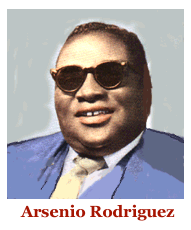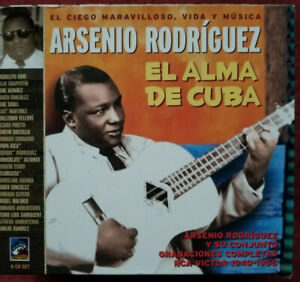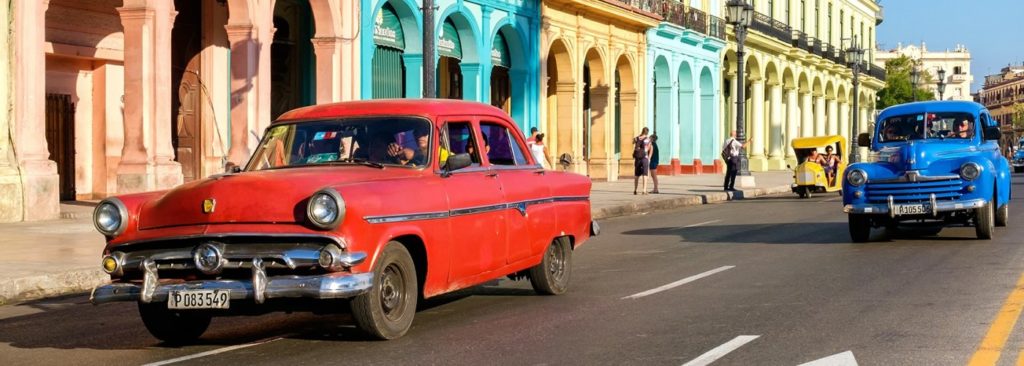ARSENIO RODRÍGUEZ, “THE MARVELLOUS BLIND MAN”, MUSICIAN, COMPOSER, AND BANDLEADER. PHOTOS/VIDEOS
Arsenio Rodríguez, born Ignacio Arsenio Travieso Scull in Guira de Macurijes, Matanzas, Cuba on August 31, 1911, was a Cuban musician, composer and bandleader. He played the tres, as well as the tumbadora, and he specialized in son, rumba, and other Afro-Cuban music styles. In the 1940s and 1950s, Rodríguez established the conjunto format and contributed to the development of the son montuno, the basic template of modern-day salsa. He claimed to be the true creator of the mambo and was an important as well as a prolific composer who wrote nearly two hundred songs. He was also called “the Marvellous Blind Man”.
His family had Kongo origins, and both his grandfather and great-grandfather were practitioners of Palo Monte. By the time Arsenio was four, in 1915, his family moved to the town of Güines, in 1918, at around 7 years of age, Arsenio was blinded when a horse kicked him in the head after he accidentally hit the animal with a broom. This tragic event prompted Arsenio to become very close with his brother Kike, and to become interested in writing and performing songs.
https://youtu.be/7oCudVfHZ88
ARSENIO RODRIGUEZ SINGS (VIDEOS)
Despite being blind since the age of seven, Rodríguez quickly managed to become one of Cuba’s foremost treseros.
RISE TO FAME
By 1938, Rodríguez was the de facto musical director of the Septeto Bellamar and his name had become familiar to important figures such as Antonio Arcaño and Miguelito Valdés. His acquaintance with the latter made it possible for one of his songs, “Bruca maniguá”, to be recorded by the famous Orquesta Casino de la Playa in June 1937. The song, featuring Valdés on vocals, became an international hit and Rodríguez’s breakthrough composition. The band also recorded Rodríguez’s “Ben acá Tomá” in the same recording session, becoming their next A-side. In 1938 they recorded “Yo son macuá”, “Funfuñando” (also a hit), and “Se va el caramelero”, which included Rodríguez’s first recorded performance, a remarkable solo on the tres.
In 1940, on the wave of his success with Casino de la Playa, Rodríguez formed his own conjunto, which featured three singers (playing claves, maracas, and guitar), two trumpets, tres, piano, bass, tumbadora and bongo. At the time, only two other conjuntos existed: Conjunto Casino and Alberto Ruiz’s Conjunto Kubavana. This type of ensemble would replace the former septets, although some such as the Septeto Nacional would perform on and off for years. Of all the conjuntos, Arsenio Rodríguez’s became the most successful and critically acclaimed one during the 1940s. His popularity earned him the nickname El Ciego Maravilloso (The Marvellous Blind Man). The first single by his conjunto was “El pirulero no vuelve más”, a pregón which tried to capitalize on the success of “Se va el caramelero”.
In 1947, Rodríguez went to New York for the first time. There, he hoped to get cured of his blindness but eye specialist Ramón Castroviejo was told that his optic nerves had been completely destroyed. This experience led him to compose the bolero “La Vida es un sueño” (Life is a dream). He returned to New York in 1948 and 1950 before establishing himself in the city in 1952. He played with influential artists such as Chano Pozo, Machito, Dizzy Gillespie, and Mario Bauzá. On March 18, 1952, Rodríguez made his final recordings with his band for RCA Victor in Cuba. He finally left Havana on March 22, 1952, having handed the direction of the conjunto to trumpeter Félix Chappottín. Chappottín and the other remaining members, including pianist Lilí Martínez and singer Miguelito Cuní, formed Conjunto Chappottín. He would return to Havana for the last time in 1956.
LATER LIFE AND DEATH
During the 1960s, the mambo craze petered out, and Rodríguez continued to play in his typical style, although he did record some boogaloo numbers, without much success. As times changed, the popularity of his group declined. He tried a new start in Los Angeles. He invited his friend Alfonso Joseph to fly out to Los Angeles with him but died there only a week later, on December 30, 1970, from pneumonia. His body was returned for burial in New York. There is much speculation about his financial status during his last years, but Mario Bauzá denied that he died in poverty, arguing that Rodríguez had a modest income from royalties.
INNOVATIONS
Rodríguez’s chief innovation, his interpretation of the son montuno, established the basic template for Cuban popular dance music and salsa that continues to this day. “It took fifty years for Latin music to catch up with what Arsenio was doing in the 1940s”—Kevin Moore (2007: web).
DISCOGRAPHY AND NOTABLE COMPOSITIONS
The following songs composed by Arsenio Rodríguez are considered Cuban standards:
“Bruca maniguá”
“El reloj de Pastora”
“Monte adentro”
“Dundunbanza”
“Como traigo la yuca” (also known as “La yuca de Catalina” or “Dile a Catalina”)
“Fuego en el 23”
“Meta y guaguancó”
“Kila, Kike y Chocolate”
“Los sitios acere”
“La fonda de el bienvenido”
“Mami me gustó”
“Papa Upa”
“El divorcio”
“Anabacoa”
“Adiós Roncona”
“Dame un cachito pa’ huelé”
“Yo no como corazón de chivo”
“Juégame limpio”
ARSENIO RODRÍGUEZ, “EL CIEGO MARAVILLOSO”, MÚSICO, COMPOSITOR Y LÍDER. VIDEOS
Arsenio Rodríguez, nacido Ignacio Arsenio Travieso Scull en Guira de Macurijes, Matanzas, Cuba el 31 de agosto de 1911, fue un músico, compositor y director de orquesta cubano. Tocaba el tres, además de la tumbadora, y se especializaba en son, rumba y otros estilos musicales afrocubanos. En las décadas de 1940 y 1950, Rodríguez estableció el formato de conjunto y contribuyó al desarrollo del son montuno, la plantilla básica de la salsa moderna. Afirmó ser el verdadero creador del mambo y fue un importante y prolífico compositor que escribió casi doscientas canciones. También fue llamado “el maravilloso ciego”.
Su familia tenía orígenes en Kongo, y tanto su abuelo como su bisabuelo eran practicantes de Palo Monte. Cuando Arsenio tenía cuatro años, en 1915, su familia se mudó al pueblo de Güines, en 1918, alrededor de los 7 años, Arsenio quedó ciego cuando un caballo lo pateó en la cabeza luego de que accidentalmente golpeara al animal con una escoba. Este trágico evento llevó a Arsenio a acercarse mucho a su hermano Kike y a interesarse por escribir e interpretar canciones.
https://youtu.be/0PhNWCpRjsw
ARSENIO RODRIGUEZ CANTA (VIDEOS)
A pesar de ser ciego desde los siete años, Rodríguez rápidamente logró convertirse en uno de los treseros más importantes de Cuba.
LLEGAR A LA FAMA
En 1938, Rodríguez era el director musical de facto del Septeto Bellamar y su nombre se había familiarizado con importantes figuras como Antonio Arcaño y Miguelito Valdés. Su conocimiento de este último hizo posible que una de sus canciones, “Bruca maniguá”, fuera grabada por la famosa Orquesta Casino de la Playa en junio de 1937. La canción, con la voz de Valdés, se convirtió en un éxito internacional y en la composición revolucionaria de Rodríguez. . La banda también grabó “Ben acá Tomá” de Rodríguez en la misma sesión de grabación, convirtiéndose en su próxima cara A. En 1938 grabaron “Yo son macuá”, “Funfuñando” (también un éxito) y “Se va el caramelero”, que incluyó la primera interpretación grabada de Rodríguez, un notable solo de tres.
En 1940, en la ola de su éxito con Casino de la Playa, Rodríguez formó su propio conjunto, que incluía tres cantantes (tocando claves, maracas y guitarra), dos trompetas, tres, piano, bajo, tumbadora y bongo. En ese momento, solo existían otros dos conjuntos: Conjunto Casino y Conjunto Kubavana de Alberto Ruiz. Este tipo de conjunto reemplazaría a los antiguos septetos, aunque algunos como el Septeto Nacional actuarían intermitentemente durante años. De todos los conjuntos, el de Arsenio Rodríguez se convirtió en el más exitoso y aclamado por la crítica durante la década de 1940. Su popularidad le valió el sobrenombre de “El Ciego Maravilloso”. El primer sencillo de su conjunto fue “El pirulero no vuelve más”, un pregón que intentó capitalizar el éxito de “Se va el caramelero”.
En 1947, Rodríguez fue a Nueva York por primera vez. Allí, esperaba curarse de su ceguera, pero el oftalmólogo Ramón Castroviejo fue informado de que sus nervios ópticos estaban completamente destruidos. Esta experiencia le llevó a componer el bolero “La Vida es un sueño”. Regresó a Nueva York en 1948 y 1950 antes de establecerse en la ciudad en 1952. Tocó con artistas influyentes como Chano Pozo, Machito, Dizzy Gillespie y Mario Bauzá. El 18 de marzo de 1952 Rodríguez realizó sus últimas grabaciones con su banda para RCA Victor en Cuba. Finalmente salió de La Habana el 22 de marzo de 1952, tras haber entregado la dirección del conjunto al trompetista Félix Chappottín. Chappottín y los demás miembros restantes, incluida la pianista Lilí Martínez y el cantante Miguelito Cuní, formaron el Conjunto Chappottín. Volvería a La Habana por última vez en 1956.
https://youtu.be/jXH8BFSZpNI
ARSENIO RODRIGUEZ CANTA (VIDEOS)
VIDA Y MUERTE
Durante la década de 1960, la locura del mambo se apagó y Rodríguez continuó tocando con su estilo típico, aunque grabó algunos temas de boogaloo, sin mucho éxito. A medida que cambiaban los tiempos, la popularidad de su grupo declinaba. Intentó empezar de nuevo en Los Ángeles. Invitó a su amigo Alfonso Joseph a volar a Los Ángeles con él, pero murió allí solo una semana después, el 30 de diciembre de 1970, de neumonía. Su cuerpo fue devuelto para su entierro en Nueva York. Se especula mucho sobre su situación económica durante sus últimos años, pero Mario Bauzá negó que muriera en la pobreza, argumentando que Rodríguez tenía unos ingresos modestos por regalías.
INNOVACIONES
La principal innovación de Rodríguez, su interpretación del son montuno, estableció la plantilla básica para la música de baile popular cubana y la salsa que continúa hasta el día de hoy. “La música latina tardó cincuenta años en ponerse al día con lo que estaba haciendo Arsenio en la década de 1940” —Kevin Moore (2007: web).
DISCOGRAFÍA Y COMPOSICIONES DESTACADAS
Se consideran estándares cubanos las siguientes canciones compuestas por Arsenio Rodríguez:
“Bruca maniguá”
“El reloj de Pastora”
“Monte adentro”
“Dundunbanza”
“Como traigo la yuca” (también conocido como “La yuca de Catalina” o “Dile a Catalina”)
“Fuego en el 23”
“Meta y guaguancó”
“Kila, Kike y Chocolate”
“Los sitios acere”
“La fonda de el bienvenido”
“Mami me gustó”
“Papá Upa”
“El divorcio”
“Anabacoa”
“Adiós Roncona”
“Dame un cachito pa ‘huelé”
“Yo no como corazón de chivo”
“Juégame limpio”
Agencies/ Wiki/ Internet Photos/ YouTube/ Arnoldo Varona/ www.TheCubanHistory.com
THE CUBAN HISTORY, HOLLYWOOD.












